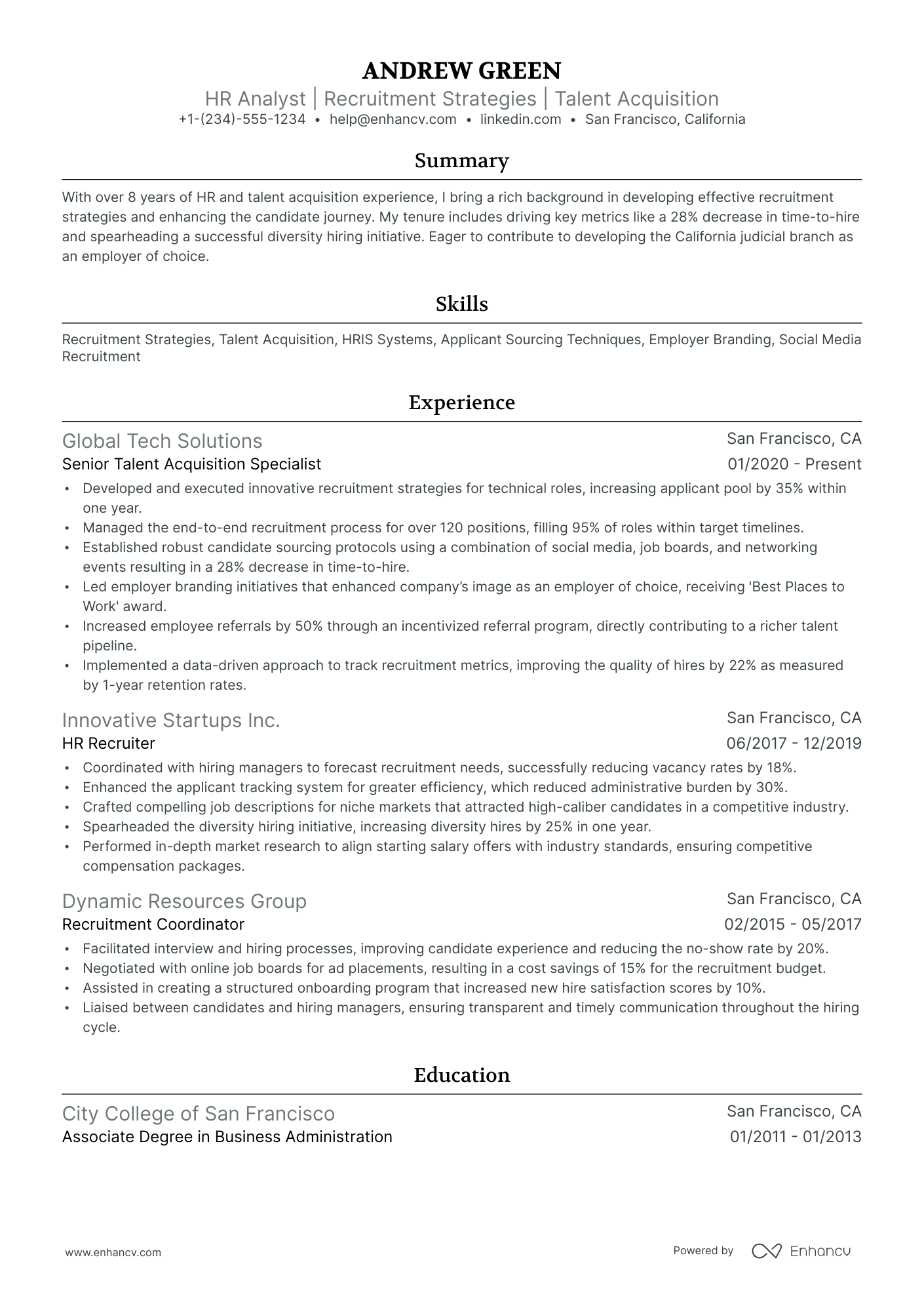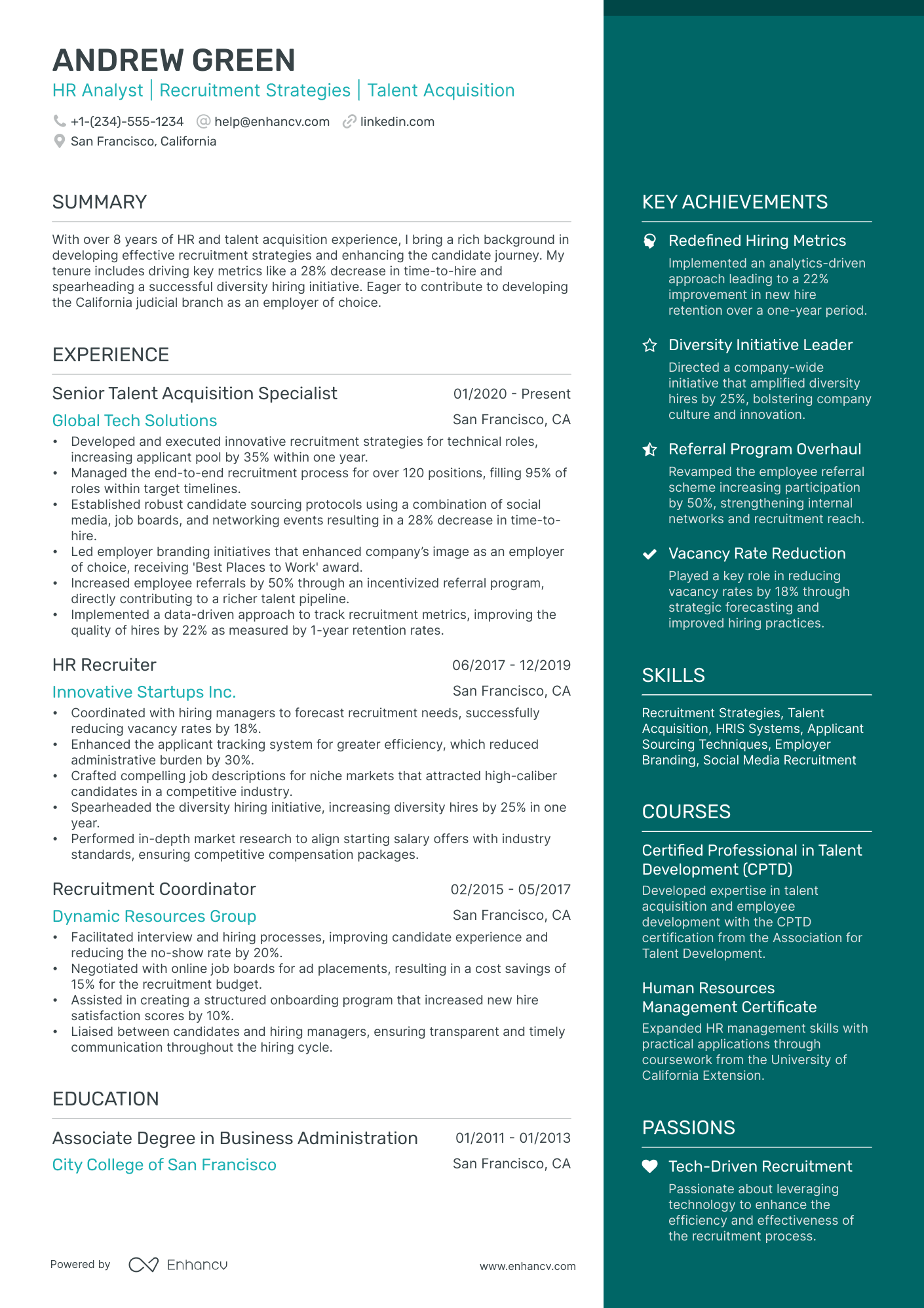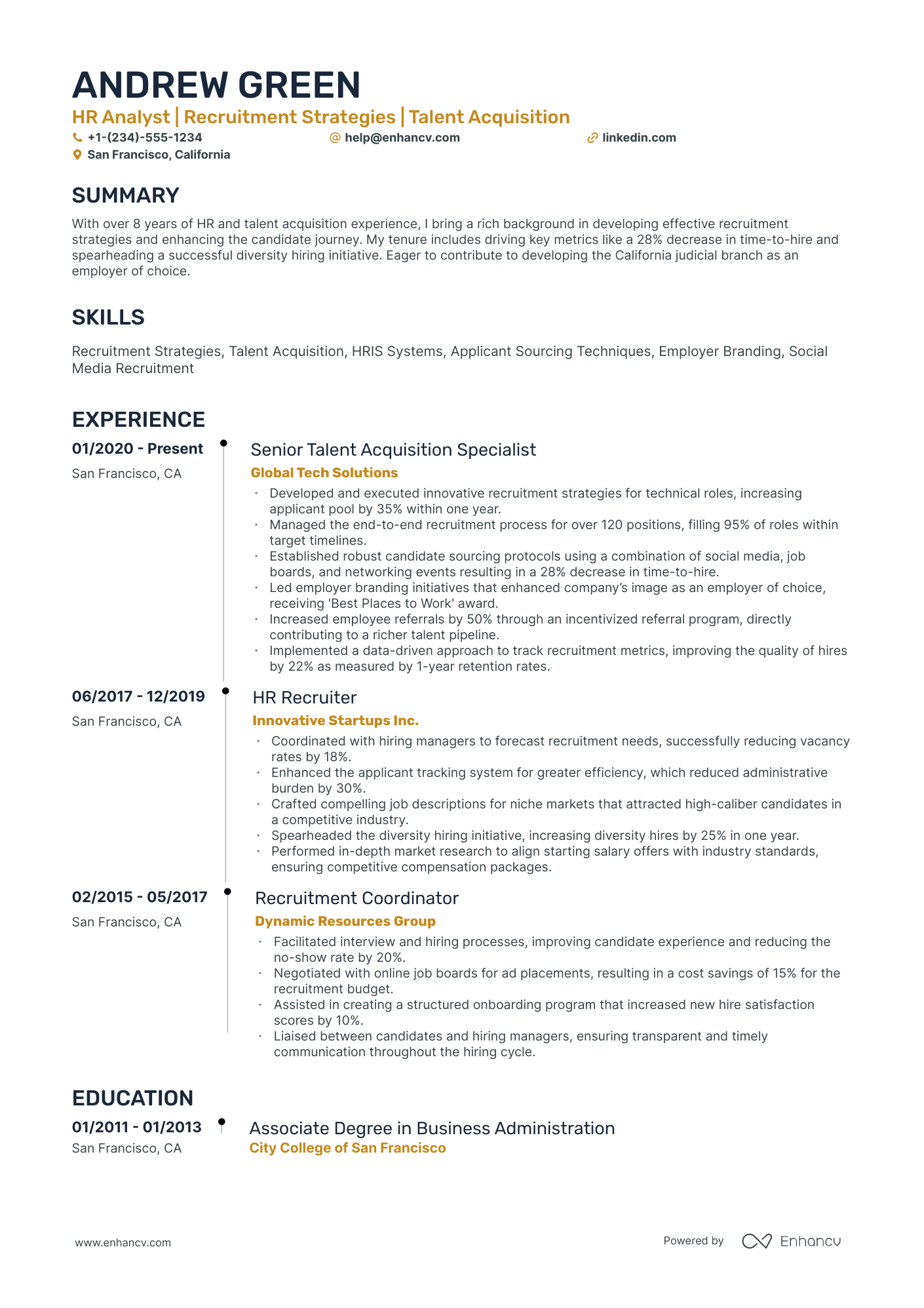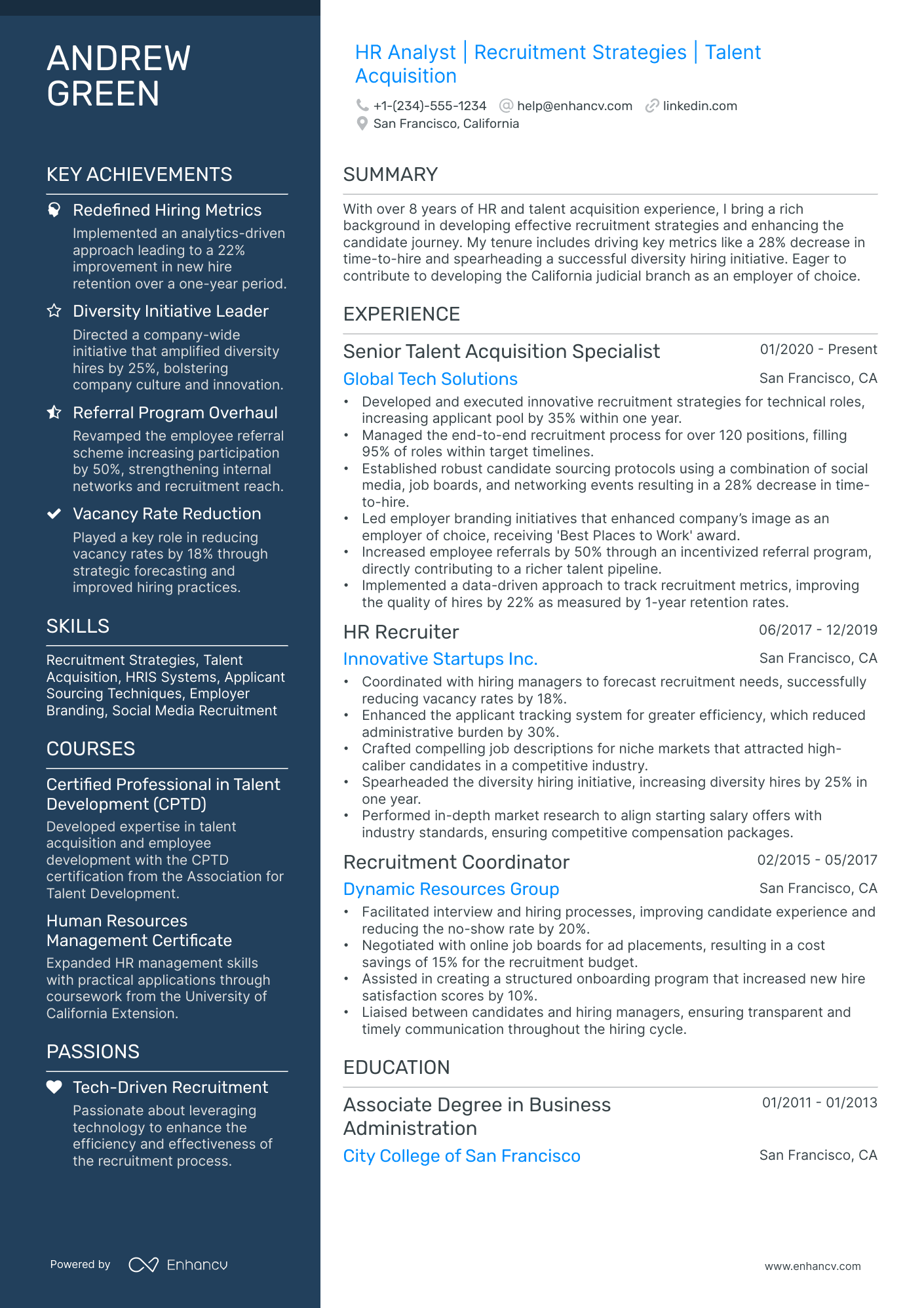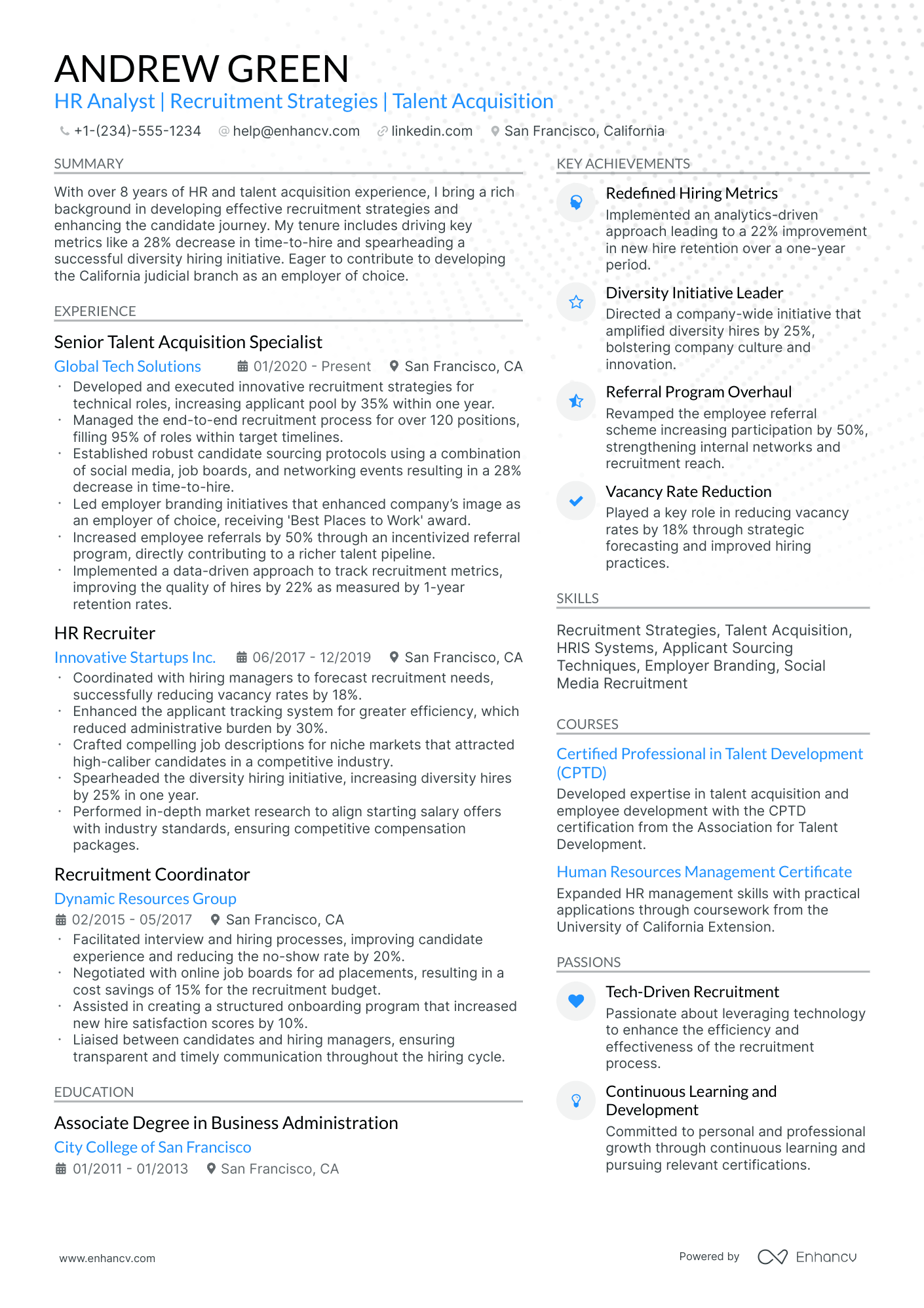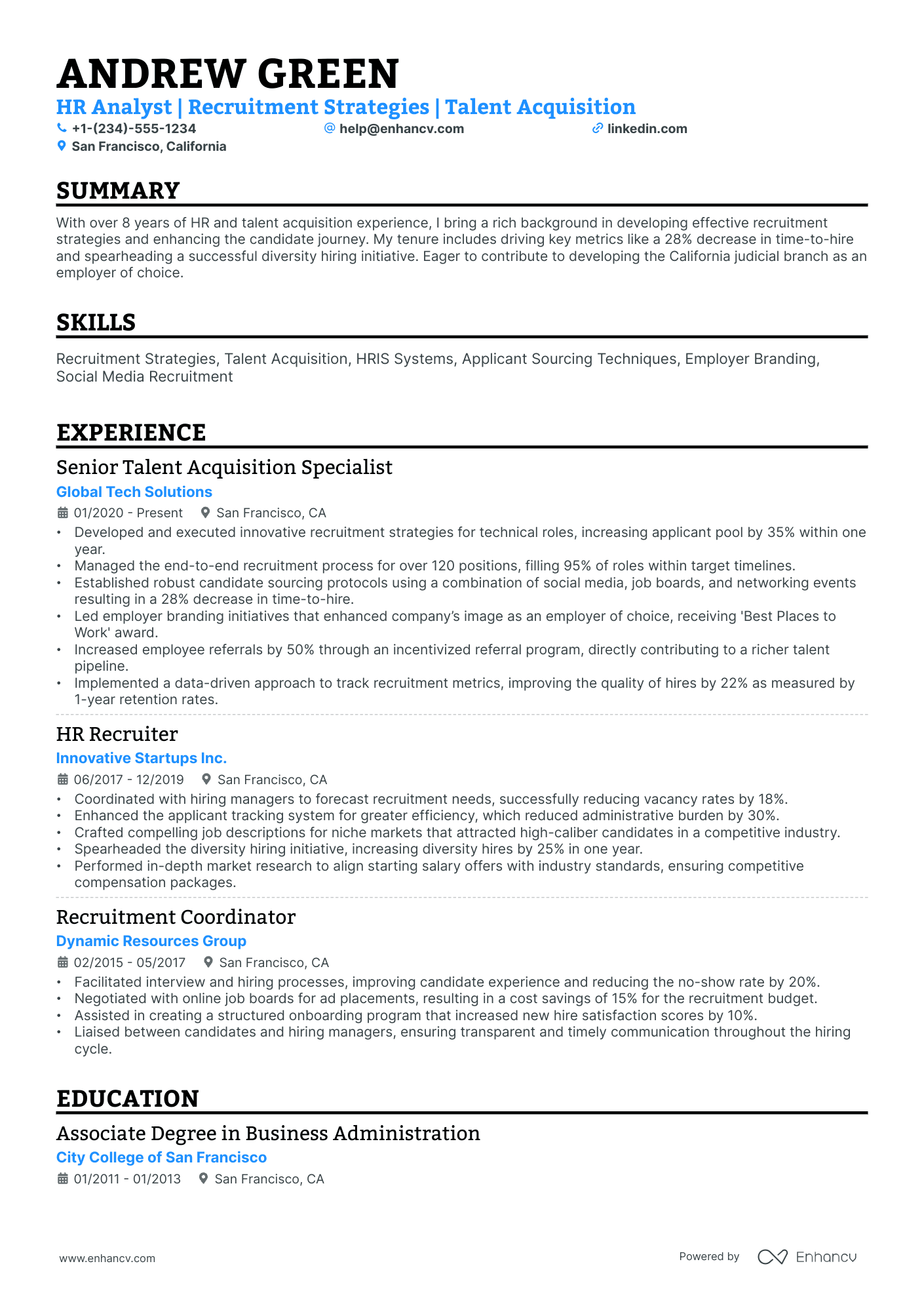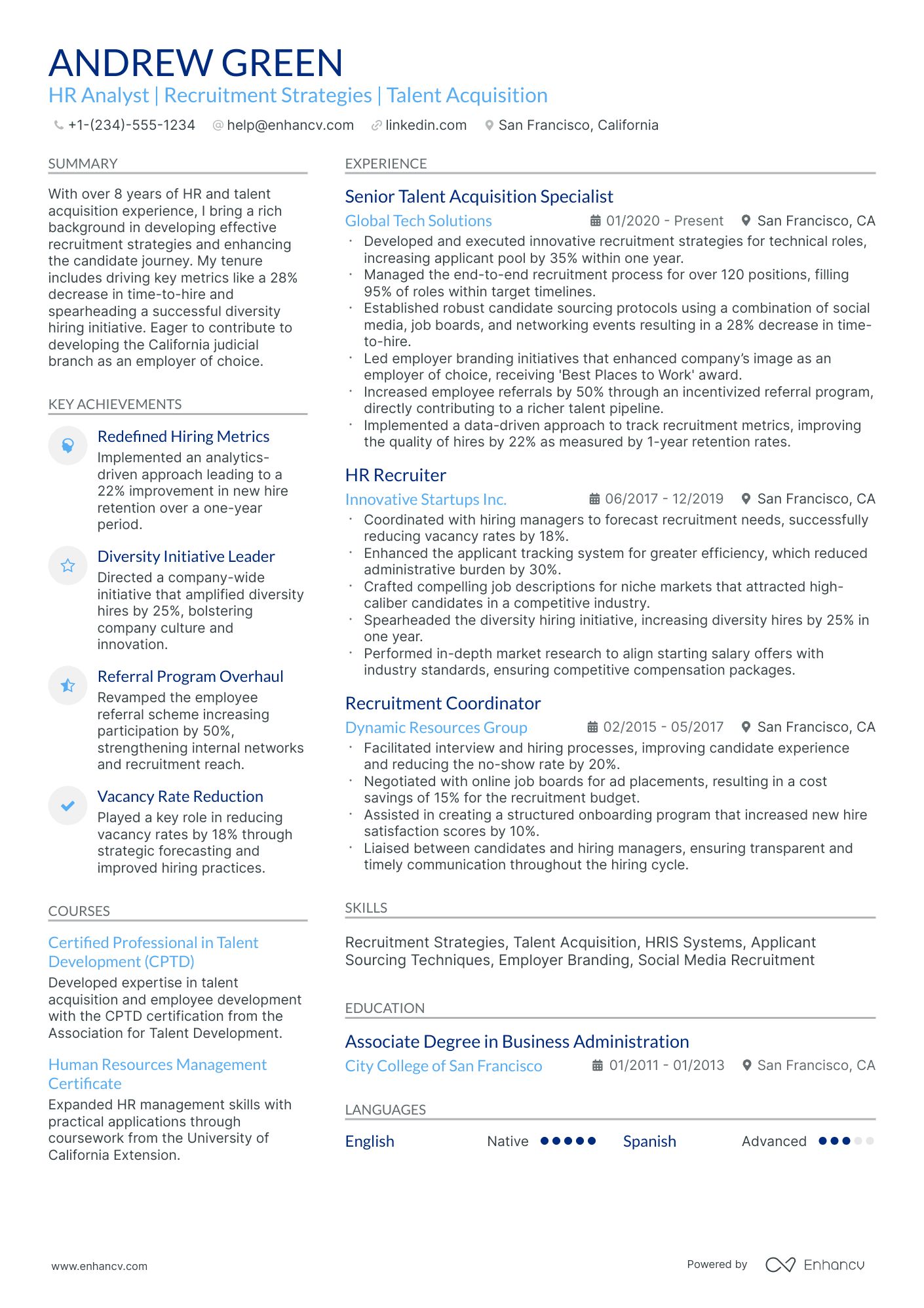One resume challenge you might encounter as an HR analyst is effectively discerning the true expertise of candidates amidst a sea of generic skills lists and buzzwords. Our guide is tailored to help you refine your evaluation techniques, ensuring you spot the genuine talent by understanding what to look for beyond the jargon.
- Sample industry-leading examples to learn how to write your best resume yet.
- Improve the experience, education, and achievements section of your resume with insights from resume-writing professionals.
- Curate your technical expertise and personality to stand out amongst the pool of candidates.
- Succinctly focus on your unique skill set all through your HR analyst resume.
If the HR analyst resume isn't the right one for you, take a look at other related guides we have:
The importance of format and layout in your HR analyst resume
Consider you're an HR professional at company X, evaluating two HR analyst candidate resumes. John Smith presents a simple, traditional, and easy-to-read resume. Edward Price, however, uses a non-conventional, often illegible format. Whose resume would you spend more time on to understand their experience? This scenario underscores the importance of your HR analyst resume’s design. It should be simply formatted and clearly communicate why you are the ideal candidate for the role.Achieve this balance by:
- Listing your experience, beginning with the most recent and relevant, in reverse chronological order;
- Ensuring your header contains essential information, such as contact details, a headline, and a portfolio link. Include a professional photo in the HR analyst resume header if you have one;
- Including only the most important and relevant resume sections to showcase your expertise and stand out from other candidates;
- Editing your HR analyst resume to be no longer than two pages if you have extensive relevant experience. Use your limited resume space judiciously.
Also, remember that your HR analyst resume might initially be scanned by an Applicant Tracker System (ATS).
When it comes to ATS:
- Opt for simple and legible fonts like Raleway, Rubik, Lato, etc., making your experience easy for the ATS to scan;
- Use serif and sans-serif fonts, both of which are ATS-friendly;
- Avoid overused options like Arial and Times New Roman, which, while suitable, may lack personality.
Contrary to a common myth, our recent study shows that the ATS can effectively process both one-column and two-column resumes. Learn more about this in the ATS myths guide.
Finally, when submitting your HR analyst resume, always export it as a PDF to ensure all information remains intact, making the document easier to print, read, and scan.
Upload & Check Your Resume
Drop your resume here or choose a file. PDF & DOCX only. Max 2MB file size.
PRO TIP
Showcase any ongoing or recent educational efforts to stay updated in your field.
Ensure your HR analyst resume stands out with these mandatory sections:
- Header - the section recruiters look to find your contact details, portfolio, and potentially, your current role
- Summary or objective - where your achievements could meet your career goals
- Experience - showcasing you have the technical (and personal) know-how for the role
- Skills - further highlighting capabilities that matter most to the HR analyst advert and your application
- Certifications/Education - staying up-to-date with industry trends
What recruiters want to see on your resume:
- Experience with HR metrics and data analysis
- Proficiency in HRIS (Human Resources Information Systems) and Excel
- Knowledge of labor laws and HR best practices
- Experience in developing and implementing HR policies and systems
- Strong data presentation and visualization skills
The HR analyst resume experience section: a roadmap to your expertise
The resume experience section provides you with an opportunity to tell your professional narrative.
Recruiters, reading between the lines of your resume, use the experience section to better understand your unique skill set, accomplishments, and what unique value you bring about.
Discover five quick steps on how to write your experience section:
- Curate only relevant experience items to the role and include the company, description, and dates; all followed by up to six bullets per experience item;
- Each experience item should feature tangible results of your actions - if you can include a number or percent, this will further highlight your aptitude;
- If you've received any managerial or customer feedback, use short excerpts of it as further social proof of your technical or people skills;
- Make sure you're using the appropriate verb tense when listing your responsibilities;
- Within the description for each role, you could summarize your most noteworthy and relevant achievements.
Now, take note of how a real-world HR analyst professional received opportunities at industry leaders with these resume experience sections:
- Leveraged advanced statistical analysis to evaluate employee performance metrics across 5 departments, improving retention rates by 18%.
- Designed and implemented a comprehensive workforce planning system that streamlined the talent acquisition process, reducing time-to-hire by 25 days.
- Collaborated with senior leadership to develop strategic HR initiatives aligned with company growth, directly contributing to a 35% increase in employee satisfaction.
- Managed the transition to a new HRIS platform, ensuring seamless data migration and 100% accuracy in employee records for a workforce of 2000+.
- Created detailed reports and dashboards for tracking key HR metrics such as turnover rates, which were utilized in executive decision-making processes.
- Conducted regular system audits and addressed discrepancies, maintaining high data integrity that supported critical HR operational functions.
- Oversee a team of five HR analysts, guiding the research and analysis of complex data sets to inform succession planning for senior roles.
- Implemented a new predictive analytics model to forecast recruitment needs, reducing labor costs by 10% while maintaining operational efficiencies.
- Partnered with IT department to launch an employee self-service portal, leading to a 40% reduction in HR inquiries and increased employee autonomy.
- Played a pivotal role in developing a company-wide diversity and inclusion tracking system, resulting in a 24% increase in minority hires over 4 years.
- Facilitated the integration of benefits and payroll systems, enhancing user experience, and reducing processing errors by 30%.
- Conducted in-depth job market analysis that influenced competitive salary adjustments for 100+ positions.
- Initiated the deployment of an AI-driven recruitment tool that decreased the average time-to-interview by three days while increasing candidate quality.
- Developed a suite of real-time HR analytics dashboards utilized by management to track performance appraisals, leading to a 20% improvement in appraisal completion rates.
- Streamlined employee onboarding procedures by automating document management, reducing administrative workload by 50 hours per month.
- Utilized predictive modeling to identify trends in employee engagement surveys, informing targeted initiatives that raised overall engagement scores by 15 points.
- Developed cost-savings strategies by analyzing benefit plan usage, saving the company $200,000 annually.
- Contributed to a high-profile project that standardized HR reporting across international subsidiaries, enhancing global operational coherence.
- Designed a machine-learning algorithm to predict attrition risks, which was instrumental in proactively addressing retention challenges.
- Established a data governance framework that increased the accuracy of HR analytics reports by 22% and supported evidence-based decision-making.
- Assisted in the restructuring of the performance management process which boosted employee productivity by aligning individual goals with company objectives.
- Orchestrated the standardization of global payroll procedures, achieving a 98% on-time payment rate and consistently high compliance levels.
- Conducted comprehensive analyses of exit interview data, revealing key factors contributing to turnover and informing retention improvements.
- Led the implementation of a learning management system that reduced training costs by 20% while increasing employee development tracking capabilities.
- Spearheaded the development of a strategic talent analytics program, guiding the C-suite in workforce planning decisions and optimal resource allocation.
- Directed a cross-functional team to optimize data visualization tools, enhancing stakeholder understanding of complex HR datasets.
- Coordinated with finance and operations to align HR metrics with business performance indicators, fostering a data-driven culture.
- Integrated business intelligence software with HR systems to provide real-time insights on labor cost analysis and budget forecasting.
- Pioneered the use of predictive analytics for talent acquisition, which has increased the quality of hires by 28% year-over-year.
- Conducted a multifaceted compensation analysis project, ensuring market competitiveness and facilitating a 5% decrease in pay disparities.
Quantifying impact on your resume
- Include the number of recruitment processes you have optimized or streamlined, demonstrating your ability to improve efficiency.
- Specify the percentage by which you increased employee retention, highlighting your understanding of engagement and morale.
- Mention the exact number of employee satisfaction surveys analyzed to showcase your data analysis skills.
- Detail the size of the workforce data you manage or analyze regularly, indicating your capacity to handle large datasets.
- State the amount of cost reduction achieved through your HR initiatives, showing your contribution to the company's financial health.
- Cite the number of training programs you have developed or facilitated, underlining your role in employee development.
- Provide the number of HR reports you generate and present to management routinely, proving your proficiency in communication and HR metrics.
- List the number of compliance audits you have conducted, evidencing your attention to legal standards and organizational policy adherence.
Action verbs for your HR analyst resume
Lacking relevant HR analyst resume experience?
Learn how to write your HR analyst resume experience in spite of having no real-world (or applicable) experience for the job.
You should:
- Feature relevant projects or publications that could impress recruiters or showcase that you have the basic skill set for the job
- Shift the focus towards your people (communication, organization, etc.) skills to demonstrate that you're a quick learner and can easily adapt to a new environment
- Use the resume objective to not only highlight your accomplishments but also map out how your career plans are perfectly aligned with the company's vision
- Select either the functional-skill-based resume format (that puts the focus on your skills) or the hybrid one (balancing expertise with skills).
Recommended reads:
PRO TIP
If you happen to have plenty of certificates, select the ones that are most applicable and sought-after across the industry. Organize them by relevance to the role you're applying for.
HR analyst skills and achievements section: must-have hard and soft skills
A key principle for your HR analyst resume is to prominently feature your hard skills, or the technologies you excel in, within the skills section. Aim to list several hard skills that are in line with the job's requirements.
When it comes to soft skills, like interpersonal communication abilities and talents, they're trickier to quantify.
Claiming to be a good communicator is one thing, but how can you substantiate this claim?
Consider creating a dedicated "Strengths" or "Achievements" section. Here, you can describe how specific soft skills (such as leadership, negotiation, problem-solving) have led to concrete achievements.
Your HR analyst resume should reflect a balanced combination of both hard and soft skills, just as job requirements often do.
Top skills for your HR analyst resume:
HRIS (Human Resource Information Systems)
Data Analysis Tools (e.g., Excel, Tableau)
SQL
HR Analytics Software (e.g., Visier, SAP SuccessFactors)
Statistical Analysis
Reporting Tools
Data Visualization
Applicant Tracking Systems (ATS)
Surveys and Feedback Tools
Performance Management Systems
Analytical Thinking
Communication
Attention to Detail
Problem-Solving
Interpersonal Skills
Organizational Skills
Adaptability
Confidentiality
Team Collaboration
Time Management
PRO TIP
If you failed to obtain one of the certificates, as listed in the requirements, but decide to include it on your resume, make sure to include a note somewhere that you have the "relevant training, but are planning to re-take the exams". Support this statement with the actual date you're planning to be re-examined. Always be honest on your resume.
Showcase academic background with education and certifications' sections
Listing your education and certifications should be a rudimentary part of your resume writing.
Including your relevant academic background - in the form of your higher education degree and niche-specific certificates - will prove knowledge of the industry.
For your education section:
- Start by including your degree, followed by start and graduation dates, as well as the institution;
- You could include relevant coursework, major/minor , or GPA, only if your've just graduated from college or if this information would further support your application;
- If you have an "ongoing" degree, you can still list it in case you think your diploma can impress recruiters or it's required;
Follow a similar logic for your certifications section by listing the institution, alongside dates you've obtained the certificate. For some of the most recent and relevant industry certificates , check out the next part of our guide:
The top 5 certifications for your HR analyst resume:
- Associate Professional in Human Resources (aPHR) - HR Certification Institute (HRCI)
- Professional in Human Resources (PHR) - HR Certification Institute (HRCI)
- Certified Professional (SHRM-CP) - Society for Human Resource Management (SHRM)
- Senior Certified Professional (SHRM-SCP) - Society for Human Resource Management (SHRM)
- Human Resource Management Professional (HRMP) - HR Certification Institute (HRCI)
PRO TIP
If the certificate you've obtained is especially vital for the industry or company, include it as part of your name within the resume headline.
Recommended reads:
HR analyst resume summary or objective? The best choice is based on your experience
If you're wondering about the relevancy of the resume summary or the resume objective to your HR analyst application - here's the truth.
The summary and objective provide recruiters with your expertise and accomplishments at a glance, within an up-to-five-sentence structure.
The difference is that the:
- Resume objective is also more focused on emphasizing your career goals. The objective is the perfect fit for (potentially more junior) candidates who'd like to balance their relevant experience with their career goals.
- Resume summary can provide you with space to also detail the unique value of what it's like to work with you. HR analyst candidates who have many noteworthy accomplishments start from the get-go with their summary.
Ensure that either type of resume introduction presents your HR analyst expertise in the best light and aligns it with the job advert.
The more details you can provide with numbers, the more compelling your resume summary or objective will be.
Real-world HR analyst candidates follow these frameworks in writing their resume summaries and objectives.
The end results are usually as such:
Resume summaries for a HR analyst job
- With over 8 years of dedicated HR analytics experience at a multinational corporation, adept at leveraging advanced data modeling and statistical analysis to inform strategic HR decisions. Key achievements include reducing turnover by 20% through predictive analytics and leading talent acquisition analytics for a workforce of 15,000.
- Seasoned financial analyst transitioning to HR analytics, bringing a track record of over 10 years in data-driven decision-making. Skilled in SQL, R, and Python with a proven ability to uncover insights that drive company growth and performance optimization, looking to apply quantitative analysis skills to human resources.
- As a former marketing strategist with 5 years of experience in customer behavior analysis, I am eager to apply my expertise in data interpretation to transform HR practices. Proficient in Tableau and SPSS, I aim to leverage my background in predictive modeling to enhance workforce planning and productivity.
- An accomplished HR professional with 6 years of experience specializing in workforce analytics, equipped with a masterful grip on advanced HRIS systems and Excel. Instrumental in redesigning compensation models that led to an improved employee satisfaction score by 15% for a leading tech firm.
- Eager to launch my career in HR analytics, I bring strong analytical skills and a fresh perspective. My objective is to harness my advanced proficiency in Excel and R, combined with my passion for human resource management, to contribute to effective talent management strategies.
- My goal as an aspiring HR analyst is to blend my keen interest in data science with my commitment to fostering employee engagement and organizational success. Through my recent academic training in human resources and proficiency in analytics tools, I am ready to deliver valuable insights.
Four more sections for your HR analyst resume
Your HR analyst resume can be supplemented with other sections to highlight both your personality and efforts in the industry. Use the ones you deem most relevant to your experience (and the role):
- Awards - to celebrate your success;
- Interests - to detail what you're passionate about outside of work (e.g. music, literature, etc.);
- Publications - to show your footprint in the wider community;
- Projects - to pinpoint noteworthy achievements, potentially even outside of work.
Key takeaways
- Invest in a concise HR analyst professional presentation with key resume sections (e.g. header, experience, summary) and a simple layout;
- Ensure that the details you decide to include in your resume are always relevant to the job, as you have limited space;
- Back up your achievements with the hard and soft skills they've helped you build;
- Your experience could help you either pinpoint your professional growth or focus on your niche expertise in the industry;
- Curate the most sought-after certifications across the industry for credibility and to prove your involvement in the field.
